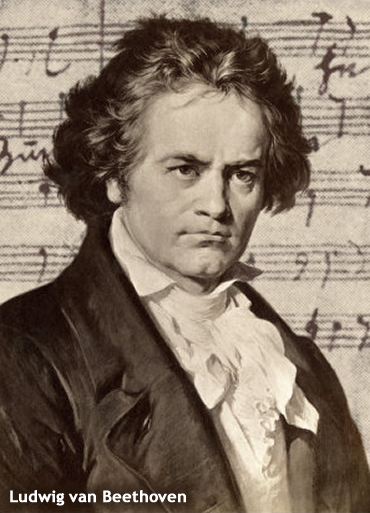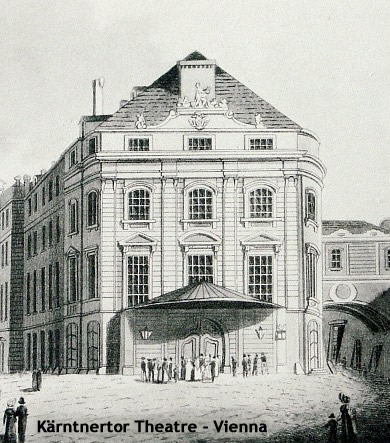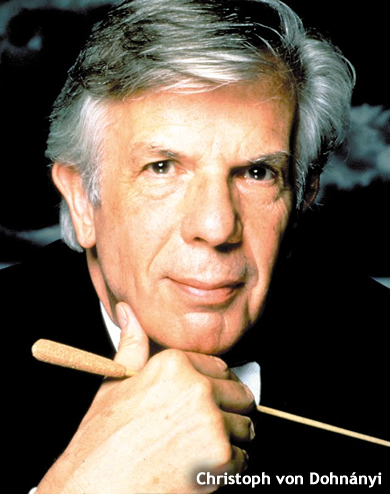 Ludwig Van Beethoven (1770-1827)
Ludwig Van Beethoven (1770-1827)
Symphony No. 9 in D Minor, Opus 125 – “Choral”
The Cleveland Orchestra (Christoph Von Dohnanyi, conductor)
Recorded in Masonic Auditorium, Cleveland on October 18 & 19, 1985
ONE-SENTENCE REVIEW:
This CD will receive my highest rating (88 Points!) for nostalgia reasons alone – this was the first CD I ever had (most kids my age were listening to Madonna) and I listened to it over and over and over again – simply amazed at the clarity and “awesomeness” of the new CD technology.
ORIGINAL LINER NOTES (written by Steven Ledbetter):
Scarcely had Friedrich Schiller’s ode An die Freude (To Joy) reached print in 1785 before composers started setting it to music, so strongly did its theme of world brotherhood and Enlightenment ideals speak to the young and idealistic.
Soon there were dozens of versions, mostly for voice and piano, so the poet can hardly have been surprised to learn through a friend in Bonn that yet another young composer was about to set his text to music. But this one was different; the friend noted: “I expect something perfect, for as far as I know him he is wholly devoted to the great and sublime.”
 The composer was Ludwig van Beethoven, then in his early twenties. Three decades elapsed before Beethoven was satisfied that he had found the way to deal with Schiller’s text, but certainly the resulting work – his final symphony – was “great and sublime.”
The composer was Ludwig van Beethoven, then in his early twenties. Three decades elapsed before Beethoven was satisfied that he had found the way to deal with Schiller’s text, but certainly the resulting work – his final symphony – was “great and sublime.”
After completing his Seventh and Eighth Symphonies in 1812, Beethoven had turned away from the genre for five years, and only began thinking about symphonies again when he received an invitation to come to London in the winter of 1817-18 and to bring two new symphonies with him. The invitation must have been attractive – it was just such a trip to England that had made Haydn a wealthy man – but in the end nothing came of it except a few sketches for two symphonies.
Several more years passed, Beethoven returned to his sketches in the summer of 1822, still planning to compose a pair of symphonies. But by the following year he had settled on a single work in the key of D Minor.
For a long time he was torn between two possible endings – one purely instrumental, the other a choral setting of Schiller’s ode. The problem, as he saw it, was how to motivate the sudden appearance of a chorus after three lengthy instrumental movements. Even after he had invented the familiar hymnlike tune and drafted the instrumental variations that mark its first appearance, he could not find a solution.
One day he was struck by the idea of having a soloist simply sing the announcement, “Let us sing the song of the immortal Schiller,” before starting the ode itself.
In the end he settled on slightly different wording, but the point was the same: to disavow the past and turn with a conscious welcome to something new and liberating. Once he actually started setting Schiller’s words, he treated them very freely, taking the passages that particularly stimulated his muse, making cuts and repetitions as the musical development required. In the end, he actually set something less than half of Schiller’s entire text and freely rearranged the rest.
 The planning of the first performance was complicated by the fact that Beethoven wanted to conduct the entire concert, an embarrassment on account of his deafness.
The planning of the first performance was complicated by the fact that Beethoven wanted to conduct the entire concert, an embarrassment on account of his deafness.
In the end he stood on stage next to Michael Umlauf, ostensibly to set the tempi, and, though he kept beating through the work, the players had been instructed to pay attention only to Umlauf’s beat.
The remainder of the all-Beethoven program included the overture Consecration of the House and three movements of the Missa Solemnis. The plan to perform part of the Mass ran into legal entanglements when Church authorities refused permission for liturgical music to be heard in the unsanctified precincts of a theater. In the end, that music was billed (in a mild subterfuge) as “Three Grand Hymns with Solo and Choral Voices.”
Though the music was of unprecedented difficulty, the crowds in the Kartnertor Theatre on May 7, 1824 responded with enthusiasm, cheering and applauding energetically, though the deaf composer, still turning the pages of the score and hearing the music in his mind, was unaware of it until one of the soloists pulled him by the sleeve to get his attention and pointed to the audience.
Like the Fifth Symphony, Beethoven’s Ninth moves from tragedy to triumph symbolized by the beginning in D minor and the close in D major. But the Fifth seems to be the triumph of an individual hero, while the Ninth, with a chorus singing Schiller’s text, becomes a universal triumph for human aspiration.
Though the text makes explicit the message of the symphony, Beethoven’s musical architecture reinforces and projects that message with unusual force. He planned the entire symphony in such a way that for the first three movements it remains locked in the realm of D minor and the closely related keys F and B-flat (they are part of the scale of D minor).
Late in the final movement F and B-flat are ousted in favor of F-sharp and B natural, notes that characterize the scale of D major. On paper this sounds like purely theoretical change, but in performance it achieves unparalleled force. Rarely in the history of music has simple harmonic relationship between major and minor modes generated greater power or feeling.
 The symphony opens with its first theme gradually appearing out of a mysterious introduction hinting at indescribable vastness. No orchestral beginning was more influential throughout the nineteenth century, though no composer has ever surpassed Beethoven in the suggestive power of this opening. And throughout the lengthy first movement, Beethoven never allows us to stray for long from powerful reminders that his symphony is in a minor key.
The symphony opens with its first theme gradually appearing out of a mysterious introduction hinting at indescribable vastness. No orchestral beginning was more influential throughout the nineteenth century, though no composer has ever surpassed Beethoven in the suggestive power of this opening. And throughout the lengthy first movement, Beethoven never allows us to stray for long from powerful reminders that his symphony is in a minor key.
The demonic scherzo of the second movement, too, fiercely reiterates the fearing of the first movement. For a moment in the middle section, Beethoven projects pure human joy in the first extensive passage in D major, but it is cancelled by the return of the scherzo.
The richly evocative lyricism of the third movement sings a pensive song in B-flat, alternating with a second, slightly faster theme in D major. But on every occasion the second theme ends up slipping helplessly back to the first key, though the variations become ever more lush and sweetly consoling.
The first sound of the finale is a “fanfare of terror” introducing Beethoven’s public search for a way to turn the minor key darkness of the opening into a firm major key conclusion. Cellos and double basses sing an operatic-style recitative (for which Beethoven originally wrote words) calling up and summarily rejecting themes from each of the earlier movements.
Finally a new idea appears, simple, singable, hymnlike, emphatically in D major (since its melody circles around F-sharp, the characteristic third step of the D major scale). The orchestra welcomes it with a set of variations. Real progress seems to be underway when this theme, too, is swept away by a renewed “fanfare of terror,” brutal and consciously ugly, containing almost every note of the D minor scale!
Here, at last, the baritone intervenes with Beethoven’s introduction to Schiller’s poem. The soloist, echoed by the chorus, sings confidently in D major, and all seems well through three stanzas of Schiller’s poem. But one more crisis remains.
 At the end of the third stanza (on the words “von Gott” – “before God”), Beethoven undercuts his modulation to the expected dominant key and throws the following passage into B-flat – once again threatening that the minor mode may prevail.
At the end of the third stanza (on the words “von Gott” – “before God”), Beethoven undercuts his modulation to the expected dominant key and throws the following passage into B-flat – once again threatening that the minor mode may prevail.
The “Turkish” march of the tenor’s solo is a melodic variant of the main theme turned into a heroic aria. An extended orchestral development follows with major and minor engaged in a last dramatic opposition.
Finally the orchestra settles on a dotted rhythm repeating the note F-sharp through three octaves – the single note that most strikingly emphasizes the main theme and its major mode harmony. After two tentative beginnings in the “wrong” key, the composer changes a single note in the bass part and suddenly “realizes” that this music is, emphatically, in D major.
The chorus returns in one of the most thrilling moments in all of music, asserting through the rest of the symphony Beethoven’s sturdy, confident answer to the questions posed by the opening.
TRACK LISTING – BEETHOVEN SYMPHONY NO. 9 ‘CHORAL’
- 1: Allegro ma non troppo un poco maestoso [15:05]
- 2: Molto vivace – Presto [11:27]
- 3: Adagio molto e cantabile [14:57]
- 4: Presto [24:32]
Here’s a video treat! Note: This is not the performance being reviewed.
http://www.youtube.com/watch?v=IInG5nY_wrU
FINAL THOUGHT:
I firmly believe it was this recording of Beethoven’s 9th by the Cleveland Orchestra conducted by Christoph Von Dohnanyi that got me hooked on classical music. I was 10 years old when I first heard this. By giving this disc to me, my parents created a classical music monster as I started to collect and listen to almost anything I could get my hands on. (I wasn’t a total freak – I also listened to Madonna and Culture Club – though maybe THAT makes me a total freak.)
 Emily Sachs – President – Manka Music Group (A division of Manka Bros. Studios – The World’s Largest Media Company)
Emily Sachs – President – Manka Music Group (A division of Manka Bros. Studios – The World’s Largest Media Company)



Hey there! Good stuff, do keep us posted when you finally post something like that!
I wish more writers of this sort of substance would take the time you did to explore and compose so well. I am exceptionally awed with your vision and knowledge. Playa del Carmen real estate
Enhance Your Workspace with Office Furniture from MTC Bespoke Furniture
Welcome to MTC Bespoke Furniture, your ultimate destination for premium office furniture designed to elevate your workspace. We specialize in creating custom, high-quality furniture solutions that combine comfort, functionality, and style. Whether you are setting up a new office or revamping an existing one, MTC Bespoke Furniture has everything you need to create a productive and aesthetically pleasing environment.
Why Choose MTC Bespoke Office Furniture?
1. Customization Options:
At MTC Bespoke Furniture, we understand that every office has unique needs. Our bespoke furniture options allow you to customize every aspect of your furniture, including materials, colors, sizes, and features. Create pieces that perfectly match your vision and requirements.
2. Ergonomic Design:
Our furniture is designed with ergonomics in mind, ensuring maximum comfort and productivity. From adjustable chairs that provide excellent lumbar support to height-adjustable desks that promote healthy posture, we prioritize the well-being of your employees.
3. Superior Quality:
We use only the finest materials and craftsmanship to produce furniture that is not only stylish but also durable. Our commitment to quality ensures that your investment will serve you well for years to come.
4. Innovative Solutions:
Stay ahead of the curve with our innovative office furniture solutions. From smart storage systems that maximize space to modular furniture that adapts to changing needs, we provide cutting-edge designs that enhance productivity and efficiency.
5. Comprehensive Selection:
Explore a wide array of office furniture, including:
Executive Desks: Command your workspace with our elegant and functional executive desks.
Office Chairs: Experience ultimate comfort with our ergonomic office chairs.
Conference Tables: Foster collaboration with our stylish and practical conference tables.
Storage Solutions: Keep your office organized with our smart storage solutions.
Reception Furniture: Make a great first impression with our welcoming reception furniture.
Our Collections
Executive Desks:
Our executive desks are designed to provide a perfect blend of functionality and style. With ample storage, sophisticated designs, and high-quality materials, these desks are ideal for any professional setting.
Office Chairs:
Experience comfort like never before with our ergonomic office chairs. Adjustable features, high-quality padding, and supportive designs ensure that you can work efficiently and comfortably throughout the day.
Conference Tables:
Our conference tables are perfect for fostering collaboration and communication. Available in various sizes and styles, these tables are designed to accommodate any meeting room setup.
Storage Solutions:
Organize your office with our innovative storage solutions. From filing cabinets to shelving units, our storage options are designed to keep your workspace tidy and efficient.
Reception Furniture:
Create a welcoming atmosphere with our stylish reception furniture. Comfortable seating and elegant designs make a great first impression on visitors and clients.
Discover the Ultimate Comfort with Ergonomic Office Chairs by MTC Bespoke Furniture
Welcome to MTC Bespoke Furniture, your go-to source for premium ergonomic office chairs designed to enhance your productivity and comfort. Our ergonomic chairs are meticulously crafted to support your body and promote a healthy posture, making them an essential addition to any workspace. Whether you work from home or in a corporate office, our chairs will provide the perfect blend of style, support, and functionality.
Why Choose Ergonomic Office Chairs from MTC Bespoke Furniture?
1. Superior Comfort:
Our ergonomic office chairs are designed to provide exceptional comfort throughout the day. With adjustable features, high-quality padding, and supportive designs, you can work efficiently without the discomfort associated with prolonged sitting.
2. Health Benefits:
Ergonomic chairs are essential for maintaining good health in the workplace. They help reduce the risk of back pain, neck strain, and other musculoskeletal issues by promoting proper posture and providing adequate lumbar support.
3. Customizable Features:
Each chair is customizable to fit your specific needs. Adjustable armrests, seat height, and backrest angles allow you to find the perfect sitting position, ensuring maximum comfort and productivity.
4. High-Quality Materials:
We use only the finest materials to craft our ergonomic chairs. From breathable mesh and premium leather to durable frames and high-density foam, our chairs are built to last and provide long-term comfort.
5. Stylish Designs:
Our ergonomic office chairs come in a variety of stylish designs that complement any office decor. Whether you prefer a modern, sleek look or a more traditional style, we have the perfect chair to match your taste.
Key Features of Our Ergonomic Office Chairs
Adjustable Lumbar Support: Provides targeted lower back support to reduce strain and promote healthy posture.
Breathable Materials: Keeps you cool and comfortable, even during long working hours.
360-Degree Swivel: Allows for easy movement and access to different areas of your workspace.
Tilt Mechanism: Enables you to recline and lock the chair in multiple positions for added comfort and relaxation.
Durable Construction: Built with high-quality materials to ensure longevity and consistent performance.
Benefits of Ergonomic Office Chairs
Increased Productivity:
When you’re comfortable, you can focus better on your tasks. Our ergonomic chairs are designed to enhance your productivity by providing a comfortable and supportive seating experience.
Improved Posture:
Proper seating posture is crucial for overall health. Our chairs are designed to encourage good posture, reducing the risk of developing chronic pain and other health issues.
Enhanced Well-Being:
A comfortable workspace contributes to your overall well-being. With our ergonomic office chairs, you can work longer and more comfortably, improving your overall work experience.
Experience the MTC Difference
At MTC Bespoke Furniture, we are committed to providing high-quality ergonomic office chairs that meet the needs of modern professionals. Our chairs are designed with your comfort and health in mind, ensuring that you can work effectively and comfortably.
Welcome to MTC Bespoke Furniture, your premier destination for high-quality, custom office furniture. Our office furniture stores offer a wide selection of ergonomic, stylish, and functional pieces designed to enhance your workspace. Whether you’re setting up a new office or upgrading your current one, MTC Bespoke Furniture has the perfect solutions to meet your needs.
Yes, I am entirely agreed with this article, and I just want say that this article is very helpful and enlightening. I also have some precious piece of concerned info !!!!!!Thanks. Buy SEO
Great article Lot’s of information to Read…Great Man Keep Posting and update to People..Thanks Edu Backlinks
Love to read it,Waiting For More new Update and I Already Read your Recent Post its Great Thanks. PBN Links
Slots website, 100 free credit, no need to share. Meet Casio online services and online football betting in the newest website of 2024 that has direct website slot games and many promotions! Slots website, 100 free credit, no need to share.
⭐️⭐️✨✨
สล็อต เว็บตรง
Useful information shared. I am very happy to read this article. thanks for giving us nice info. Fantastic walk-through. I appreciate this post. Architectural Photography
I think this is an informative post and it is very useful and knowledgeable. therefore, I would like to thank you for the efforts you have made in writing this article. slot gacor hari ini gampang menang
Very informative post ! There is a lot of information here that can help any business get started with a successful social networking campaignslot gacor hari ini gampang menang
I read a article under the same title some time ago, but this articles quality is much, much better. How you do this.. 1win промокод
Truly, this article is really one of the very best in the history of articles. I am a antique ’Article’ collector and I sometimes read some new articles if I find them interesting. And I found this one pretty fascinating and it shouメールレディld go into my collection. Very good work!
CMOLDS stands out as a premier mobile app development company, blending innovation with expertise to craft cutting-edge digital solutions. With a focus on client satisfaction and technological finesse, we empower businesses to thrive in the mobile-first world. Discover bespoke app development tailored to elevate your digital presence and drive success.
The material and aggregation is excellent and telltale as comfortably. 1вин промокод
A debt of gratitude is in order for giving late reports with r espect to the worry, I anticipate read more.
sultan69
I’ve been looking for info on this topic for a while. I’m happy this one is so great. Keep up the excellent work. pistoncars.com